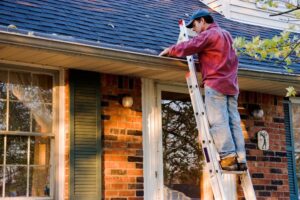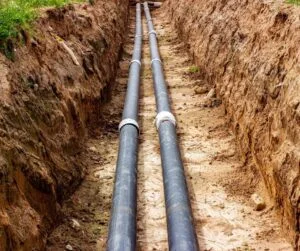
Why Regular Gutter Cleaning is Essential
Your home’s gutters play a crucial role in protecting your property from water damage. They channel rainwater away from your roof, walls, and foundation, preventing

Taking care of your home through regular maintenance and repairs can have a big impact on your homeowner’s insurance rates. Insurers closely analyze property risk factors to determine premiums, so reducing hazards around your house directly leads to lower rates in most cases. Let’s explore the relationship between maintaining your home systems and exterior and what you pay for homeowners insurance.
Before issuing a policy, home insurers carefully evaluate the level of risk posed by a dwelling and property. Some key areas they focus on include:
Insurers view homes with the best maintenance and newest systems as less risky to insure. Let’s explore this concept more.
Table 1: Factors That Influence Insurance Premiums
Factor | Description | Effect on Premium | Additional Details |
Claims History | Past at-fault accidents for auto; previous claims for home/business | Increase | Multiple claims can increase premiums by 30-50%. Claims stay on record for 3-5 years. |
Location | Geographic area’s disaster risk; crime rate | Increase or decrease | Coastal areas tend to have higher hurricane/flood risk resulting in pricier premiums. |
Age | Typically lower for older, more experienced drivers | Increase or decrease | Drivers under 25 often pay more as they pose a higher accident risk. |
Vehicle Make/Model | Repair costs; safety ratings; theft rate | Increase or decrease | Luxury and sports cars are more expensive to insure due to high repair bills. Poor safety ratings also increase premiums. |
Credit History | Viewed as an indicator of responsible financial decisions | Increase or decrease | Exceptional credit can lower premiums up to 5-10% over poor credit in most states. |
Business Type | Industry loss patterns dictate baseline rates | Increase or decrease | High-risk sectors like construction pay more while professional services pay less. |
Coverage Limits | Higher limits mean more risk taken on by the carrier | Increase or decrease | 100/300/100 liability coverage cheaper than 250/500/250 limits. |
Home insurance companies directly connect proper home maintenance with lower risk. The longer systems or areas of your home fall into disrepair, the more likely serious damage can occur. Damage leads to expensive claims that raise your risk profile with insurers.
Let’s examine some of the most important areas of home maintenance and how neglecting them heightens home insurance risk:
Insurers want to see you address minor issues with home systems before they turn into substantial problems. Letting repairs pile up demonstrates a disregard for home maintenance that makes underwriters view you as a riskier customer.
Table 2: Major Causes of Home Insurance Claims
Cause | Average Claim Severity | Frequency | Prevention Tips |
Water damage | $10,000 | 32% of claims | Inspect pipes, water heater; Install leak detectors |
Wind/Hail damage | $5,000 | 18% | Regularly inspect roof; Trim trees near home |
Theft | $2,500 | 12% | Alarm system; Lock all doors/windows |
Fire | $45,000 | 5% | Smoke detectors; Replace old appliances |
Pipe leaks | $15,000 | 14% | Insulate pipes; Repair drips promptly |
Over 90% of major insurers feature some discounts or incentives for certain protective home devices and repairs:
Taking advantage of these savings opportunities directly reduces your premiums. Installing protective devices also slashes the chances you’ll actually need to file claims down the road.
Some carriers even provide discounted rates if you bundle systems like smoke detectors with monitoring services. Activating professional monitoring demonstrates extra precaution.
Bundling your home and auto insurance with the same provider tends to unlock additional maintenance-related savings too. Insurers reward cross-selling opportunities with further premium reductions.
Postponing needed home repairs might seem like a money-saving tactic, but it frequently backfires by exacerbating issues:
These types of major catastrophes resulting from delayed maintenance often cost exponentially more than addressing them early on.
You might even have trouble getting coverage for flood damage from burst pipes or surface water if you failed to promptly address known maintenance problems like clogged gutters directing rainwater into the basement. Insurers can deny such claims due to homeowner negligence.
Perhaps somewhat surprisingly, your past homeowner’s insurance claims directly correlate to your current premium. Insurers always review policyholders’ claims history when annual renewal time approaches:
Since higher premiums stick with you for 3 to 5 years after a claim, avoiding expensive damage incidents saves you money both today and into the future.
Many insurers only forgive one claim over a multi-year period. But if you demonstrate a pattern of chronic expensive claims tied to inadequate home maintenance, you’ll almost certainly witness skyrocketing premiums or non-renewal threats.
The connection between home maintenance and insurance premiums is impossible to ignore when you look at the data. Spending a little now to care for your most valuable asset pays dividends through reduced risk and policy costs over the long run.
At Branco Insurance Group, our goal is to provide our clients with the best possible coverage to protect what matters most – your family and your business. As an independent insurance agency, we have the flexibility to work with various top-rated carriers to find policies tailored to your unique needs and budget.
We recognize choosing insurance can feel overwhelming. That’s why our experienced local agents make it a priority to fully understand your situation first before making recommendations. We’ll listen carefully to learn about your family, home, vehicles, assets, and goals to gain insight into potential risks. With a comprehensive view of your exposures, we can then educatively guide you through options to pick the ideal mix of policies and limits.
Unsure what kind of coverage or how much you require? We encourage you to connect with us. We’re happy to discuss your circumstances in depth to determine what makes sense. Our job is not just to sell you insurance – it’s to provide solutions and peace of mind. We work hard every day to earn your continued trust and confidence in the years ahead.
Please reach out with any questions about selecting the proper protection for what matters most in your life. We’ll help you make an informed decision that brings both security and value to your hard-earned dollars.
The top 3 factors that influence homeowners insurance premiums are:
Common reasons for sharp homeowners rate hikes include filing one or more claims in the last 5 years, changes increasing your home's value, renovations, lapses in coverage, credit score drops, and moving to a new location with higher risk. Carriers also raise prices across the board periodically.
Industry-wide home insurance rates rose over 10% on average in 2023 due to soaring inflation and materials/labor costs getting passed onto consumers. This led insurers to increase premiums to match higher potential replacement/repair costs. Major disasters in recent years also contributed to insurers attempting to limit exposure through higher premiums.
Insurers consider many elements about the home itself including age, structure composition materials, roof condition, electrical/plumbing system maintenance, and safety mechanisms. They also evaluate risk factors related to the property's location like natural disasters and crime stats. Your credit score and claims history also impact pricing greatly.

Your home’s gutters play a crucial role in protecting your property from water damage. They channel rainwater away from your roof, walls, and foundation, preventing

As a homeowner, protecting your investment goes beyond the structure of your home. It also includes safeguarding essential systems and addressing potential risks. Two valuable
